Brand Guidelines
These brand guidelines are to help steer and deliver consistent creative content for the Concentrate brand. Please refer to this document when creating visual or verbal collateral under the Concentrate name.
Our focus
At Concentrate, we're passionate about helping technology and other complex B2B organisations grow. We help them use the HubSpot CRM platform to be smarter about how they attract, convert and delight more customers.
Our pragmatic team and structured approach mean we're always focused on what we've promised and can deliver the momentum needed to achieve it.
- Chapter 1 Visual identity
- Chapter 2 Logotypes
- Chapter 3 Colourways
- Chapter 4 Title and font application
- Chapter 5 Art direction
- Chapter 6 Compositional guideline
- Chapter 7 Image groups and usage
- Chapter 8 Verbal identity
- Chapter 9 Brand voice
- Chapter 10 Tone of voice
- Chapter 11 Grammar and mechanics
Visual identity
When creating visuals for Concentrate make sure that our focus, pragmatism, energy and drive shine through. Use these visual guidelines to help the Concentrate brand stand out.
Logotypes
To allow for clear brand recognition across all Concentrate channels we have two logo types: our primary and our secondary.
Primary logo
The primary logo has been designed to suit rectangular formats. It should be used across all content that is not square.
 Primary logo colourways
Primary logo colourways
Primary logo white space
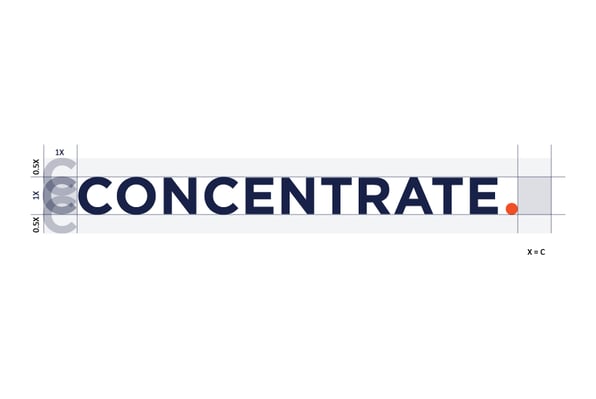 To ensure visibility, if the primary logo will appear at less than 20 px high or 20 mm high use the secondary logo type instead.
To ensure visibility, if the primary logo will appear at less than 20 px high or 20 mm high use the secondary logo type instead.
Secondary logo
The secondary logo has been designed to accommodate small and square formats. If you're creating content that will display the logo type below 20 px high or 20 mm high or is in a square format, use the secondary logo type. The secondary logo type must not be displayed at below 16 px high.
Secondary logo colourways
Secondary logo white space

Colourways
Primary colours
Our primary colours are our core colours. These should be used as the base colours of any design
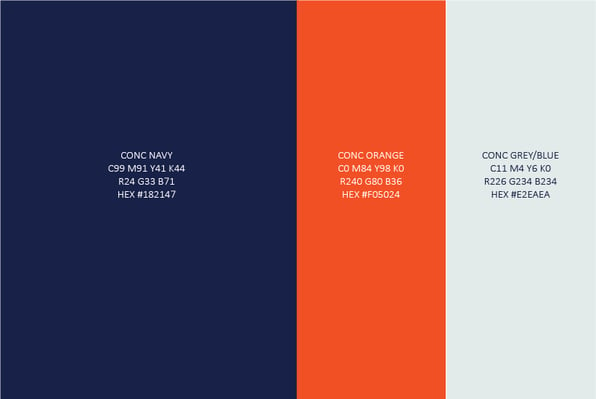
Secondary colours
Our secondary colours have been selected to highlight and complement our primary colours. Use them as an accent or to highlight important text.

Colour accessibility
Our brand colourways have been selected to ensure that our content is legible and accessible to all. When combining colours, we need to make sure that we provide enough contrast to meet accessibility guidelines. We've tested the colour combinations below to make sure they meet AA standards.

Title and font application

Our brand typefaces are Poppins and Lora. Poppins is a contemporary sans-serif with circular geometry that connects to our graphic themes. Lora is a classic serif font chosen for its legibility.
Art direction
Graphic language
Our graphic language represents our proven formula for growth. It encompasses our energy, drive, and our innate ability to build growth momentum for our clients. Its abstract appearance symbolises what we do and how we do it. It's the basis of our graphic identity and can be used to enhance our verbal messaging to keep our audience engaged.

Application methods
Do not use the graphic language in conjunction with other photographic elements. It should stand alone to maximise impact. Typography can be applied on top of and in parallel to. To incorporate other brand messaging with other visual themes follow the compositional guidelines and imager tiers outlined below.
Compositional guidelines
Grid system
For most formats, we use a 6-column grid. This grid helps us position text, graphics and imagery.
Examples:


For photography and other visual collateral our graphic language can be used in the following compositions.
Composition group one: Energetic drive
Energetic drive imagines our distinctive logo dot in motion. It represents our ability to build growth momentum for our clients. It does not correspond to a particular message. Use the appropriate photographic elements explained in the image tiers below to connect our visual identity to our written word.
Position
The energetic drive compositional element can move to align with any element of the grid (as outlined below). It can be placed both horizontally and vertically and can emerge from both the left- and right-hand sides. The curved edge should not touch the composition's outer perimeter (outlined below in red).
Application uses
Expansive horizontal

Inverted horizontal

Expansive vertical

Inverted vertical

Examples of correct use






Examples of incorrect use
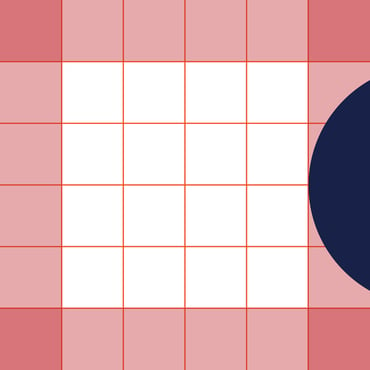
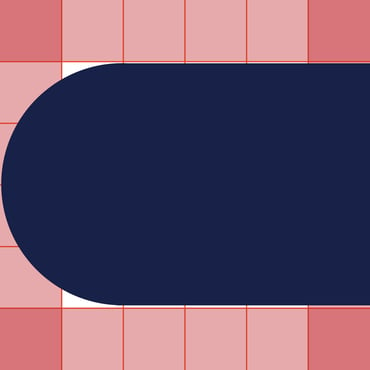


Composition group two: Accelerated growth
Accelerated growth depicts our growth formula applied to our distinct logo dot. It does not correspond to a particular message. Use the appropriate photographic elements explained in the image tiers below to connect our visual identity to our written word.
Expansive

Inverted

Position
The circle compositional element must align with both horizontal and vertical grid lines. It can only emerge from the bottom, left and right edges. It must bleed over two edges at a time. The compositional shape must not exceed the opposing edges perimeter or fall below 2x2 grid size.


Image groups and usage
Image tiers and usage
Our art direction for imagery is split into four groups to most accurately represent our niche B2B focus, our pragmatism, energy and drive.
Image group 1: Technology +
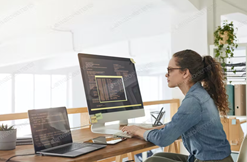

Corresponds to messaging around our niche B2B focus and our clients.
- Mid-crop contextual shots of varying tech and complex B2B industry environments - Note: do not use images of the Concentrate team
- Warm colour treatment
- Neutral (eye-level) angle
Image group 2: Personable - the faces behind our name


Corresponds to messaging around who we are, our team and our approach.
- Mid-crop shots of Concentrate employees at work
- Approachable characteristics
- Warm and saturated colour treatment
Image group 3: Energy & drive - let's get moving


Corresponds to messaging around what we do and how we deliver.
- Contextual environmental shots of Concentrate employees at work
- Wide, neutral to high-angle shots
- Emotive
- Warm colour treatment
Image group 4: Pragmatic: We'll take the most logical approach


Corresponds to messaging around our focus and structured style of working.
- Mid-crop of shots Concentrate employees in action at work
- Approachable and warm emotive
Verbal identity
When creating copy for Concentrate make sure that our niche focus and passion for enabling business growth shines through. Use these verbal guidelines to communicate Concentrate to the world.
What would Growen do? (WWGD?)
Growen embodies the Concentrate brand. His industry experience means that he's knowledgeable in all areas of B2B marketing and is an expert in using tech to digitally transform businesses and foster growth. Growen is friendly but not afraid to get to the point. If you're ever in doubt just think, WWGD (what would Growen do)?
Brand voice
Every great brand has a distinct voice and ours is no different. To keep what you write aligned with how we want to communicate, always remember our brands voice should speak to these key values.
Energetically pragmatic
Friendly and approachable
Factual yet personable
1. Speak with energy and passion
Writing with energy and passion doesn’t mean you need to increase your use of exclamation points! In fact, we'd rather you didn’t!
To write energetically make your sentences short, sharp, and to the point. For passion, remember our ‘why’; helping B2Bs grow with momentum. In all, write with the intent to attract and engage our audiences through well-chosen, thoughtful and optimistic words.
Make sure you use a lot of verbs, first and second-person narratives (we, I, you etc.,) and an active voice.
Example dos and don’ts
Instead of
Concentrate have been continual supporters of HubSpot for many years and they could be considered a loyal fan.
[Indirect, long-winded, unconfident, third person]
Try
We’re unabashed HubSpot fans.
[Direct, concise, confident]
2. Convey our approachable and friendly team
Our brand is all about helping B2B tech and complex organisations grow. We're a friendly bunch and are keen to have this conveyed in our written word. Our copy should centre around positivity and focus on what is, rather than what is not.
Examples dos and don’ts
Instead of
The Concentrate focus revolves around complex B2B companies and how they can ensure their products don't fail in new and foreign markets.
[Negative, impersonable]
Try
Our passion is helping complex B2B organisations build momentum for continued growth.
[enthusiastic, positive, descriptive, personable]
3. Deliver valuable facts in a personable way
Our services stem from our industry experience, insights and of course, data. Facts and figures define what we consult to our clients so it makes sense that they would appear in our copy. We want our audience to know we speak their language but can do so in a fun and personable way. When appropriate don't be afraid to add humour or quick wit to your copy.
Examples dos and don’ts
Instead of
Recently the team at Concentrate conducted a research and analysis project of the marketing and sales spends of publicly listed SaaS companies and found that Zoom was the biggest spender.
[not personable, no statistical data from research included]
Try
After analysing a bunch of publicly listed SaaS companies, the biggest spender on sales and marketing? Zoom, with a whopping 73% of expenditure.
[conversational/personable, direct, engaging, data focussed]
Or
In a SaaS context especially, this blog argues that customer success is the product. That is, a satisfied punter is key to any growth aspirations.
[personable, direct, engaging, funny]
Tone of voice
While we love a bit of witty banter, it's not always appropriate. Although our voice never changes, we've added tonal variants to ensure our content suits its audience. Use the following table to identify how you can adapt our brand voice to suit the appropriate context.
Relatable
We prioritise sounding human. While we aim to speak concisely, we want the sentiment to feel relaxed and relatable to our audience.
Leader
Establishing authority in the B2B space is important to us. We've been around for some time and have a fair bit of experience to share. We want to encourage our audience to feel confident following our lead.
Trustworthy
We want a reputation as a good service provider. Reliability and trust are important to us. We want our prospects and clients to know we value this from our first interaction with them to our last.
Enthusiastic
We need our passion for the industry to be well-known. If we can put an uplifting, inspiring or optimistic spin in our copy, then we should.
Humorous
We aim to add additional value where we can. Adding some gentle humour to our copy makes us relatable in a human and friendly way.
Grammar and mechanics
Adhering to certain rules of grammar and mechanics helps us keep our writing clear and consistent. This section will lay out our house style, which applies to all our content unless otherwise noted. (We cover a lot of ground in this section—the search feature will help if you're looking for something in particular.)
Basics
Write for all readers. Some people will read every word you write. Others will just skim. Help everyone read better by grouping related ideas together and using descriptive titles and subtitles.
Focus your message. Create a hierarchy of information. Lead with the main point or the most important content, in sentences, paragraphs, sections and pages.
Be concise. Use short words and sentences. Avoid unnecessary modifiers.
Be specific. Avoid vague language. Cut the fluff.
Be consistent. Stick to the copy patterns and style points outlined in this guide.
Grammar guidelines
Abbreviations and acronyms
If there’s a chance your reader won’t recognise an abbreviation or acronym, spell it out the first time you mention it and specify the abbreviation or acronym in parentheses.
First use: Customer Relationship Management (CRM)
Second use: CRM
If the abbreviation or acronym is well-known and understood like HTML, it is okay to leave it as is.
Active voice
Use active voice. Avoid passive voice.
In active voice, the subject of the sentence does the action. In passive voice, the subject of the sentence has the action done to it.
Yes: Marti logged into the account.
No: The account was logged into by Marti.
Words like “was” and “by” may indicate that you’re writing in passive voice. Scan for these words and rework sentences where they appear.
One exception is when you want to specifically emphasise the action over the subject. In some cases, this is fine.
Capitalisation
For titles, subtitles and all other heading types we use sentence case. In sentence case you capitalise the first word.
Example
The best ways to grow your tech business overseas
The only exceptions to this rule are for proper nouns (names), colons or numerical titles.
Example: Title with proper noun
The best way to grow your tech business overseas using HubSpot
Or
Example: Title with colon
Using HubSpot for lead gen: How to grow your Kiwi tech business overseas
Or
Example: Numerals in titles
6 Ways to grow your tech business overseas
Numbers
Spell out a number when it begins a sentence, unless it is a title of some kind. Any number under 10 should be spelled out at any time.
In text numeral examples:
Ten new employees started on Monday, and 12 start next week.
I ate three doughnuts at coffee hour.
Meg won first place in last year’s cycling contest.
We hosted a group of 15-year-olds who're learning to code.
Sometimes it feels weird to use the numeral. If it's an expression that typically uses spelled-out numbers, leave them that way.
Examples:
A friendly welcome email can help you make a great first impression.
That is a third-party integration.
Put your best foot forward with the all-in-one marketing platform that grows with you.
After you send your newsletter, Freddie will give you a high-five.
Numbers over 3 digits get commas:
999
1,000
150,000
Write out big numbers in full. Abbreviate them if there are space restraints, as in a tweet or a chart: 1k, 150k.
Dates
Generally, spell out the day of the week and the month. Abbreviate only if space is an issue.
Saturday, January 24
Sat., Jan. 24
Decimals and fractions
Spell out fractions.
Yes: two-thirds
No: 2/3
Use decimal points when a number can’t be easily written out as a fraction, like 1.375 or 47.2.
Percentages
Use the % symbol instead of spelling out "percent" unless the word percent is spoking within quotation marks e.g., "We saw a 22 percent turnaround in our sales lead generation efforts."
Ranges and spans
Use a hyphen (-) to indicate a range or span of numbers.
Example
It takes 20-30 days.
Money
When writing about currency, use the appropriate country currency symbol before the amount e.g., $20.00. For currency symbols used by multiple countries make sure the country currency code is in front of the symbol e.g., USD $70.00.
Telephone numbers
Use dashes without spaces between numbers. Use a country code if your reader is in another country.
06-751-9045
+64-06-751-099045
Temperature
Use the degree symbol and the capital C abbreviation for Celsius.
Example
Yes: 28°C
No: Twenty-eight degrees Celsius
Dates and Time
Use numerals and am or pm, with a space in between. Don’t use minutes for on-the-hour time.
7 am
7:30 pm
Use an En Dash (–) between times to indicate a time period.
7 am–10:30 pm
Specify time zones when writing about an event or something else people would need to schedule.
When referring to international time zones, spell them out following our abbreviations and acronyms guidelines.
Example
First use: New Zealand Standard Time (NZST)
Second use: NZST
Abbreviate decades when referring to those within the past 100 years.
the 00s
the 90s
When referring to decades more than 100 years ago, be more specific:
the 1900s
the 1890s
Punctuation
Apostrophes
The apostrophe’s most common use is making a word possessive. If the word already ends in an s and it’s singular, you also add an ’s. If the word ends in an s and is plural, just add an apostrophe.
The doughnut thief ate Sam’s doughnut.
The doughnut thief ate Chris’s doughnut.
The doughnut thief ate the managers’ doughnuts.
Apostrophes can also be used to denote that you’ve dropped some letters from a word, usually for humour or emphasis. This is fine but do it sparingly.
Colons
Use a colon to join 2 related phrases. If a complete sentence follows the colon, capitalise the 1st word.
I was faced with a dilemma: I wanted a doughnut, but I’d just eaten a bagel.
Commas
When writing a list, avoid using the Oxford comma.
Yes: David admires his parents, Oprah and Justin Timberlake.
No: David admires his parents, Oprah, and Justin Timberlake.
Otherwise, use common sense. If you’re unsure, read the sentence out loud. Where you find yourself taking a breath, use a comma.
Dashes and hyphens
Use a hyphen (-) without spaces on either side to link words into single phrase, or to indicate a span or range.
Examples:
first-time user
Monday-Friday
Use an Em Dash (—) without spaces on either side to offset an aside. Make sure you use a true Em Dash, not hyphens (- or --).
Yes: Multivariate testing—just one of our new Pro features—can help you grow your business.
Austin thought Brad was the doughnut thief, but he was wrong—it was Lain.
No: Multivariate testing -- just one of our new Pro features -- can help you grow your business.
Austin thought Brad was the doughnut thief, but he was wrong - it was Lain.
Ellipses
Ellipses (...) can be used to indicate that you’re trailing off before the end of a thought. Use them sparingly. Don’t use them for emphasis or drama, and don’t use them in titles or headers.
“Where did all those doughnuts go?” Christy asked. Lain said, “I don't know...”
Ellipses, in brackets, can also be used to show that you're omitting words in a quote.
“When in the course of human events it becomes necessary for one people to dissolve the political bands which have connected them with another and to assume among the powers of the earth, [...] a decent respect to the opinions of mankind requires that they should declare the causes which impel them to the separation.”
Full stops
Full stops go inside quotation marks. They go outside parentheses when the parenthetical is part of a larger sentence, and inside parentheses when the parenthetical stands alone.
Christy said, “I ate a doughnut.”
I ate a doughnut (and I ate a bagel, too).
I ate a doughnut and a bagel. (The doughnut was Sam’s.)
Leave a single space between sentences.
Question marks
Question marks go inside quotation marks if they’re part of the quote. Like periods, they go outside parentheses when the parenthetical is part of a larger sentence, and inside parentheses when the parenthetical stands alone.
Exclamation points
Use exclamation points sparingly. They’re like high-fives: A well-timed one is great, but too many can be annoying.
Exclamation points go inside quotation marks. Like periods and question marks, they go outside parentheses when the parenthetical is part of a larger sentence, and inside parentheses when the parenthetical stands alone.
Quotation marks
Use quotes to refer to words and letters, titles of short works (like articles and poems) and direct quotations.
Periods and commas go within quotation marks. Question marks within quotes follow logic—if the question mark is part of the quotation, it goes within. If you’re asking a question that ends with a quote, it goes outside the quote.
Use single quotation marks for quotes within quotes.
Who was it that said, “A fool and his doughnut are easily parted”?
Brad said, “A wise man once told me, ‘A fool and his doughnut are easily parted.’”
Semicolons
Go easy on semicolons. They usually support long, complicated sentences that could easily be simplified. Try an em dash (—) instead, or simply start a new sentence.
Ampersands
Don't use ampersands unless one is part of a company or brand name e.g., Ben & Jerry's.
Quotes
When quoting someone in a blog post or other publication, use the present tense.
“Using HubSpot has helped our business to grow,” says Jamie Smith.
Names and titles
The first time you mention a person in writing, refer to them by their first and last names and include their position and company. On all other mentions, refer to them by their first name.
Capitalise individual job titles when referencing to a specific role. Don't capitalise when referring to the role in general terms.
Yes: Mary Sue Tompkins, Marketing Manager, HubSpot.
Yes: Mary Sue, the Marketing Manager at HubSpot.
No: Being the Marketing Manager had its perks.
On first mention, write out New Zealand. On subsequent mentions, NZ is fine. The same rule applies to any other country or federation with a common abbreviation (European Union, EU; United Kingdom, UK).
URLs and websites
Capitalise the names of websites and web publications. Don’t italicise.
Avoid spelling out URLs, but when you need to, leave off the http://www.
Slang and jargon
Write in plain English. If you need to use a technical term, briefly define it so everyone can understand.
Text formatting
Use italics to indicate the title of a long work (like a eBook, white paper or blog) or to emphasise a word.
Use italics when citing an example in step-by-step instructions: When you're all done, click Send.
Left-align text, never centre or right-aligned.
Leave one space between sentences, never 2.
Write positively
Use positive language rather than negative language. One way to detect negative language is to look for words like “can’t,” “don’t,” etc.
Yes: To get a doughnut, stand in line.
No: You can’t get a donut if you don’t stand in line.

